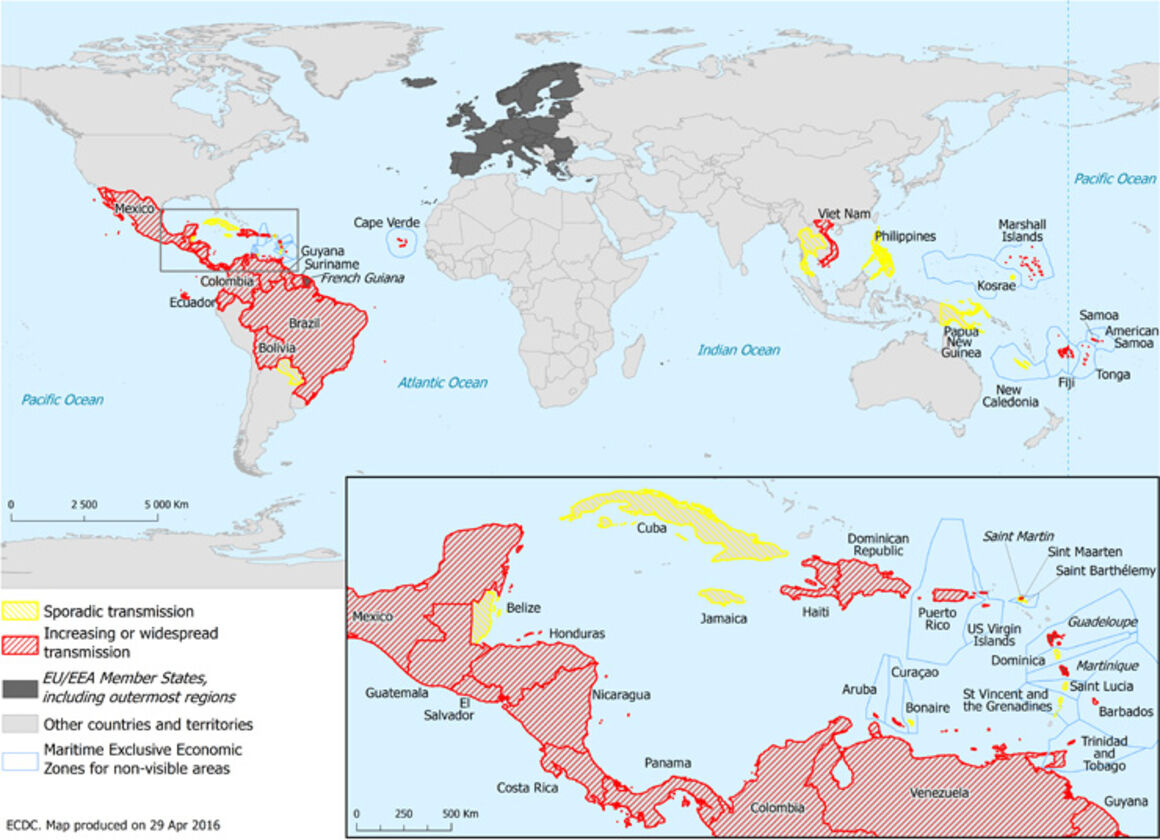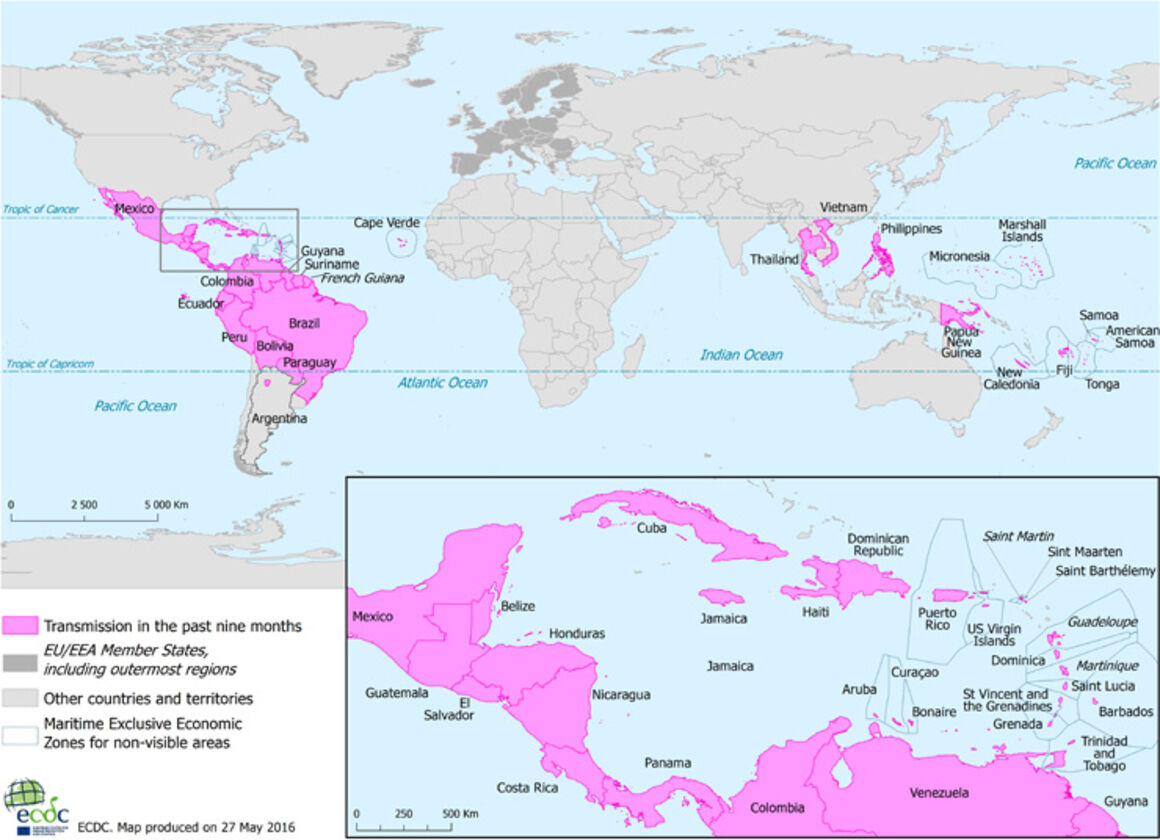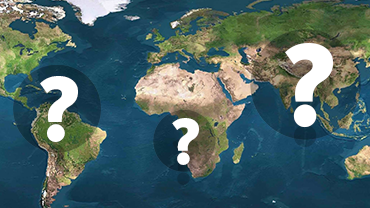Epidemiological update: Outbreaks of Zika virus and complications potentially linked to the Zika virus infection
As of 28 January 2016, autochthonous cases of Zika virus infection were reported from 26 countries or territories worldwide in the past two months
The Zika virus epidemic continues to spread in the Americas. Since the last week, four additional countries or territories have reported laboratory confirmed autochthonous transmission:
- Nicaragua, US Virgin Island, Dominican Republic and Curaçao.
As of 28 January 2016, autochthonous cases of Zika virus infection were reported from 26 countries or territories worldwide in the past two months (see Table 1 and Figure 1):
- Barbados, Bolivia, Brazil, Cabo Verde, Colombia, Curaçao, Dominican Republic, Ecuador, El Salvador, French Guiana (France), Guadeloupe (France), Guatemala, Guyana, Haiti, Honduras, Martinique (France), Mexico, Nicaragua, Panama, Paraguay, Puerto Rico (USA), Saint Martin (France), Suriname, Thailand, Venezuela, Virgin island (USA).
In addition as of 28 January 2016, five countries or territories reported autochthonous cases of Zika virus infection in the past nine months (see Table 1 and Figure 2):
- Fiji, Maldives, New Caledonia (France), Samoa, Solomon Islands.
Table 1. Countries or territories with reported confirmed autochthonous cases of Zika virus infection, as of 28 January 2016
|
Affected in the past 2 months |
Affected in the past 9 months |
|---|---|---|
Barbados |
Increasing or widespread transmission |
Yes |
Bolivia |
Sporadic transmission following recent introduction |
Yes |
Brazil |
Increasing or widespread transmission |
Yes |
Cabo Verde |
Increasing or widespread transmission |
Yes |
Colombia |
Increasing or widespread transmission |
Yes |
Curacao |
Sporadic transmission following recent introduction |
Yes |
Dominican Republic |
Increasing or widespread transmission |
Yes |
Ecuador |
Increasing or widespread transmission |
Yes |
El Salvador |
Increasing or widespread transmission |
Yes |
French Guiana |
Increasing or widespread transmission |
Yes |
Guadeloupe (France) |
Sporadic transmission following recent introduction |
Yes |
Guatemala |
Increasing or widespread transmission |
Yes |
Guyana |
Sporadic transmission following recent introduction |
Yes |
Haiti |
Increasing or widespread transmission |
Yes |
Honduras |
Sporadic transmission following recent introduction |
Yes |
Martinique (France) |
Increasing or widespread transmission |
Yes |
Mexico |
Increasing or widespread transmission |
Yes |
Nicaragua |
Sporadic transmission following recent introduction |
Yes |
Panama |
Increasing or widespread transmission |
Yes |
Paraguay |
Increasing or widespread transmission |
Yes |
Puerto Rico |
Increasing or widespread transmission |
Yes |
Saint Martin (France) |
Sporadic transmission following recent introduction |
Yes |
Suriname |
Sporadic transmission following recent introduction |
Yes |
Thailand |
Sporadic transmission following recent introduction |
Yes |
Venezuela |
Increasing or widespread transmission |
Yes |
Virgin island (US) |
Sporadic transmission following recent introduction |
Yes |
Fiji |
No |
Yes |
Maldives |
No |
Yes |
New Caledonia (France) |
No |
Yes |
Samoa |
No |
Yes |
Solomon Islands |
No |
Yes |
EU/EEA and Outermost EU Regions
As of 28 January, no autochthonous Zika virus transmission has been reported in the EU. However, in 2015 and 2016, the media, quoting Ministries of Health reported several EU countries with imported cases who had recently travelled in affected countries/territories. These countries are Denmark, Finland, Germany, Italy, Portugal, the Netherlands, Spain, Sweden, and the UK. In Europe outside the EU, Switzerland reported imported cases as well.
Several outermost EU regions continue to report Zika virus autochthonous circulation: Martinique, Guadeloupe, Saint Martin and French Guiana.
In addition, Curacao (an independent state and part of the Kingdom of the Netherlands) reported an autochthonous case.
- Martinique: From December 2015 to 17 January 2016, 1 255 suspected cases and 102 confirmed cases were reported by the local health authorities. Among them, 652 suspected cases and 55 confirmed cases were reported in week two. The 102 confirmed cases are from 19 cities.
- French Guiana: From December 2015 to 17 January 2016, authorities reported 164 suspected cases and 45 confirmed cases. Among them, 114 suspected cases and 15 confirmed cases were reported in week two. The 102 confirmed cases are from six cities.
- Guadeloupe: on 15 January, a confirmed autochthonous case was reported.
- Saint Martin: on 15 January, a confirmed autochthonous case was reported.
- Curaçao: on 28 January, a confirmed autochthonous case was reported.
Figure 1. Countries or territories with reported confirmed autochthonous cases of Zika virus infection in the past two months, as of 28 January 2016

Note: the map does not indicate the extent of the autochthonous transmission in the countries.
Figure 2. Countries or territories with reported confirmed autochthonous cases of Zika virus infection in the past nine months, as of 28 January 2016

Note: the map does not indicate the extent of the autochthonous transmission in the countries.
Update on the observed increase of congenital microcephaly and other central nervous system malformations in Brazil
According to the Ministry of Health of Brazil weekly epidemiological update on the monitoring of microcephaly published on 27 January, 4 180 suspected cases of microcephaly have been reported since week 45 2015, of which 732 (17.5%) were investigated and classified. Of the 270/732 (37%) confirmed cases with central nervous system malformations, 6/270 (2.2%) were positive for Zika virus infection.
Additional information may be found in the latest ECDC rapid risk assessment, 22 January 2016.





